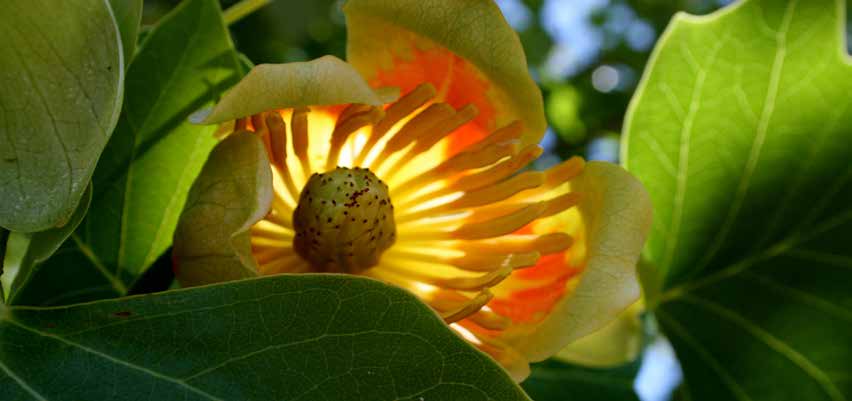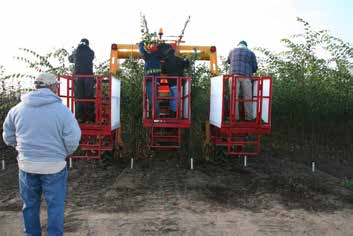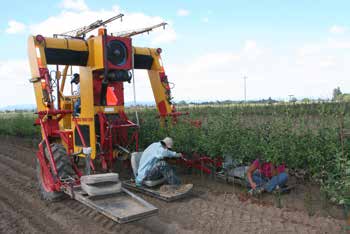Liriodendron tulipifera – Tulip Tree

During my college years I had the great opportunity to work at our local garden center on weekends and in between classes. When I wasn’t unloading the daily delivery of annuals and veggie flats, my time was spent helping customers design and pick appropriate trees and shrubs for their newly finished homes. Oftentimes the customers had some idea of what they were looking for based on a plant they had seen around older subdivisions known for their spring flowers or their fall leaf colors. Many times the customer would come in and ask me for the “tulip tree” with the pretty flower. Easy enough! Walking down the rows on our way to the Liriodendron the customer would stop at the Magnolias proclaiming that this is the tree they were looking for. After a little Latin and nomenclature lesson, explaining the difference between a true tulip tree and a Magnolia, we usually ended up loading the Magnolia.
The true tulip tree is just as beautiful in its flower as the Magnolia, usually creamy greenish yellow petals with an inside rim of sun blaze to a sunset circle ready to catch the early spring rain. The flowers usually become more prolific later in its life after it shakes some of its juvenility. Liriodendron tulipifera, in fairness to my garden center customers, is also called Tulip Magnolia or Tulip Poplar, but most likely was named for its tulip-like flowers. The bark on the Liriodendron is similar to the color of a gray squirrel. It’s contrasted however with dots of small white speckles that stand out only after you focus your eyes for a while.

The summer leaves of this tree are quite unique sporting a lime green to spearmint green color on the most blunted ends similar to a snow shovel. The leaves are large with three to four lobes making it a nice shade tree with a mature height of 80’. Tulip tree is not one you would want to plant close to the house. It’s utilized more in park settings but not street ways or sidewalks. Usually we see them planted around larger parcels of property where horses or cattle are within eyesight. Here in Oregon the tree is a fast grower with little maintenance required. They are truly a wonderful allee tree with great fall colors of yellow and gold.
There are a couple of keys to handling this tree early in the production fields. First, this tree must be trunk wrapped to protect it from sun scald in the first year.
A simple stretchy cardboard material can be procured at many nursery supply stores. Secondly, Liriodendron is an aggressive grower. Pruning to get proper branch angles will minimize breakage in storms. It also helps to keep the head in proportion to the roots. Next, its roots are fibrous and one of the most distinguishable in the bareroot coolers, having a spaghetti like look. Extra irrigation is needed as the fibrous roots are unable to completely support the trees moisture loss the first summer.
My favorite selection of tulip tree is the columnar form ‘Arnold’. This selection is superbly upright and tight in form with a height of 50-60’ and width of 15-20’. When touring the nursery with visitors, ‘Arnold’ always requires a stop for picture taking. This selection and the straight species are both hardy to Zone 4.
Liriodendron “tulip tree” is a great selection if you are looking to add some diversity to your product line.
Platform for success
Striving to come up with ideas to make tasks as efficient as possible should never be considered challenging. Clear and effective ideas in efficiency often come from teamwork. A focus group is an excellent representation of teamwork, sharing thoughts and experiences from a collaborative mix of skillsets. Participants in a focus group can include supervisors, mechanics, safety team members, equipment operators and employees, who present firsthand knowledge of the task. Guidelines and goals are fundamental concepts in a focus group for directing idea sharing, final proposal, course-of-action and lastly the implementation of the thoughts for improving a task.
Featured in the PlantLine previously, the Damcon Multitrike has been a centerpiece in multiple focus groups. Recently, fall topping (i.e. pruning), a skilled, labor driven task, was challenged in a focus group to improve efficiencies and immediately ideas swarmed around the Damcon due to its ability to tackle multiple rows with a single pass.

In the end, with little time the focus group produced three high-reach working platforms. Each platform is connected to the multi-trike’s 3-point mounts which give the operator the ability to raise the platform and worker to the accommodating height to prune terminals. The thoughts stemmed from the focus group incorporated other activities including terminal tying and stake extension application. Additional creative thoughts wove safety considerations (grip strut) and practical features (small, attachable toolbox) and the design of the platform.

Spawning from the concept of high-reach it was apparent low-reach work platforms would be useful. A quasi focus group met to tackle color coding which involves many hours bent over painting stripes on trees for identification purposes. The focus group felt low reach platforms would lessen the aches on the employee as well as improved efficiencies. The low-reach platform features repurposed farm tractor chairs and “paint-cup” holders. Teamwork played a pivotal role to get all accomplished in a short period for a functioning concept. Like the high reach platform, the end result was successful and appreciated.
Efficiencies or other procedural concepts regarding tasks can be handled effectively as a team through focus groups. Evaluating tasks from simple to complex is the primary starting point. Set realistic goals to achieve success and accept failures. As ideas become realities from the initial onset, the reward is seeing the change in the habits of your employees thus giving more opportunities to improve tasks.